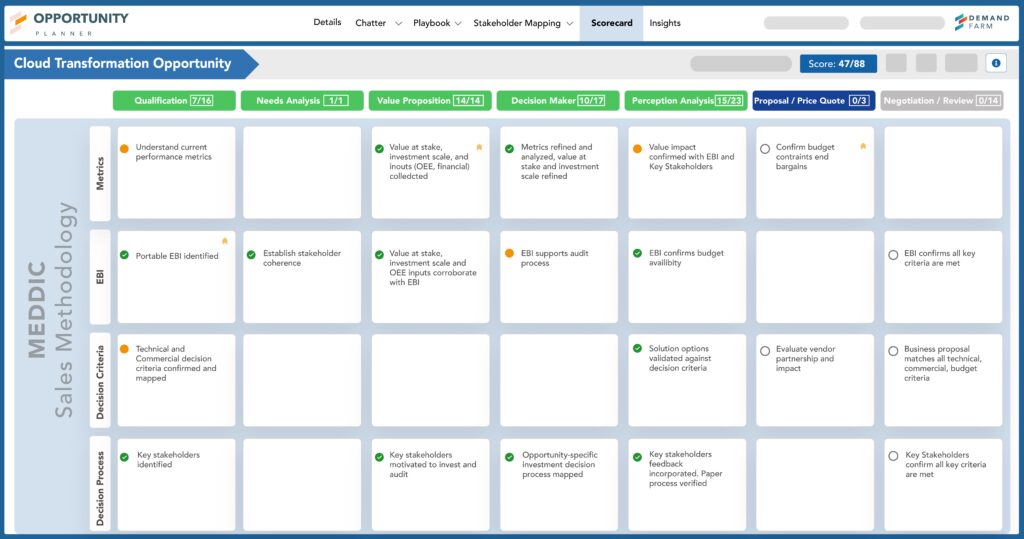Developed by Jack Napoli and Dick Dunkel at PTC, MEDDPICC has a proven history of success in managing complex sales cycles time and again. Using the MEDDIC framework, the duo increased PTC’s sales from $300 million to $1 billion in just four years, a remarkable achievement in tech sales.
I want to break down the MEDDPICC framework, compare it with its predecessor, MEDDIC, and explain why this methodology has become a vital part of modern sales strategies.
Learn more: Complete Guide on Sales Methodologies to Win Large Deals
Key Components of the MEDDPICC Sales Methodology
The MEDDPICC methodology is built around eight components: Metrics, economic buyer, Decision Criteria, Decision Process, Identifying Pain, Champion, Paper Process, and Competition. These elements equip with a structured approach to qualifying leads and navigating the complex sales processes.
Navigating Sales Complexities with MEDDPICC
Sales today isn’t what it used to be. With longer cycles, more stakeholders, and the complexities of multi-threaded sales, you need a framework that tackles these challenges head-on and offers a clear path to success.
That’s where MEDDPICC comes in!
MEDDPICC breaks down the sales process into manageable parts, ensuring that the salesperson covers each critical aspect thoroughly. In my 15+ years of the sales journey, I have seen many of my customers use MEDDPICC to align their strategy with their client’s needs, organize internal processes, and manage competition effectively.
I’ve observed adopting MEDDPICC fosters continuous improvement and professional development in your approach, boosting your performance and driving success for your entire organization.
Let’s dive into what makes MEDDPICC so impactful, why it’s an essential tool, and how it’s applied in today’s sales landscape.
What is MEDDPICC?
MEDDPICC is a detailed framework that guides the SDR through the B2B sales process. Each element represents a key step in the cycle, ensuring no stone is left unturned.
Metrics
Understanding and aligning with my client’s key performance indicators (KPIs) is crucial to me. It’s not enough to meet these metrics; I must ensure they’re realistic and achievable within my sales plan. If a client’s goal is a 15% sales increase within a year, I should be able to demonstrate how my solution can help reach that target by improving efficiency or market reach.
Economic Buyer
Identifying the person with budgetary authority is essential. Often, this means navigating complex corporate hierarchies and understanding who holds the real decision-making power. For example, when pitching a new CRM to a large company, I need to know whether the CFO or the Head of IT will sign off on the purchase, as each has different concerns.
Decision Criteria
I take the time to understand the factors my client uses to make purchasing decisions. This allows me to tailor my approach to meet their specific needs. If data security is their top priority, I emphasize our solution’s superior encryption and compliance with industry standards.
Decision Process
Map out the decision-making process within the client’s organization—who’s involved, the timeline, and any needed approvals. Knowing this helps me plan follow-ups and anticipate potential slowdowns. If the process involves a technical review, a pilot phase, and a final executive review, I should be ready for each step.
Paper Process
Never underestimate the importance of the administrative side of a sale. Ensuring that all documentation is complete and compliant is critical to avoid delays. For example, if extensive legal review is required, I ensure all documents are prepared and easily accessible to keep things moving.
Identify Pain
Uncovering and understanding my customer’s pain points is non-negotiable. I analyze their challenges to show how my solution can address them directly and effectively. If high customer churn is a concern, I illustrate how my product can improve customer satisfaction and retention.
Champion
Prioritize identifying and cultivating a champion within the client’s organization—someone who believes in my solution and can advocate for it internally. This person acts as your ally, providing insights and helping me sway opinions in your favor.
Competition
Understanding my competition’s strengths and weaknesses allows me to position my solution effectively. If my competitor’s product is cheaper but lacks reliability, I highlight my solution’s robust performance and long-term value. This way, I can make my offering stand out and address potential client objections proactively.
M E D D P I C C
“I’ve seen how MEDDPICC pushes sales teams to dig deeper—not just understanding the ‘what’ but the ‘why’ behind every metric, decision criterion, and stakeholder. This approach reshapes engagement, making every touchpoint more strategic and impactful.”
— Pawanjeet Singh, VP of Sales at DemandFarm
MEDDPICC vs. MEDDIC framework: Which is the right one for you?
MEDDPICC evolved from the original MEDDIC framework, adding two crucial components: Paper Process and Competition. While MEDDIC covers Metrics, economic buyer, Decision Criteria, Decision Process, Identifying Pain, and Champion, MEDDPICC tackles the increased complexity of today’s sales environment by addressing these additional elements. The “P” for Paper Process acknowledges how important administrative efficiency and compliance have become. The “C” for Competition ensures I’m aware of my competitors and can strategically position against them.
Step-by-Step Process of MEDDPICC
Here are a few observations I’ve made from watching the MEDDPICC framework being implemented across various clients:
- Define Metrics: Identify the KPIs that matter most to my client, making sure your solution aligns with customer goals.
- Identify the Economic Buyer: Pinpoint who has budgetary control and tailor your strategy to their concerns.
- Understand Decision Criteria: Engage with clients to grasp the factors they prioritize in their purchasing decisions.
- Map the Decision Process: Outline the steps in their decision-making, including who’s involved and any required approvals.
- Manage the Paper Process: Ensure that all necessary documentation is ready to minimize delays.
- Identify and Address Pain Points: Conduct an in-depth analysis to understand their challenges and position my solution as the answer.
- Cultivate a Champion: Nurture relationships with internal advocates who can support my solution.
- Analyze the Competition: Do a competitive analysis to highlight my unique value proposition.
Here is a quick explainer video by MEDDICC on implementing MEDDPICC in 10 Minutes!
Benefits I have Observed with MEDDPICC:
- Comprehensive Coverage: Every aspect of the sales process is accounted for.
- Structured Process: A clear framework keeps me focused and consistent.
- Enhanced Client Understanding: I gain deeper insights into client needs and align my approach accordingly.
- Competitive Edge: Awareness of competitors helps me position myself strategically.
- Improved Sales Efficiency: Streamlined processes reduce delays and boost productivity.
- Professional Development: Mastering MEDDPICC has sharpened my skills and credibility in the industry.
How to Implement MEDDPICC or MEDDIC
Choosing between MEDDIC and MEDDPICC depends on your specific business needs. I can’t overlook the importance of consistent implementation and governance of whichever framework I choose.
For that, tools like DemandFarm’s opportunity planning software are invaluable. It helps implement proven methodologies like MEDDIC and MEDDPICC to assess and qualify worthy sales opportunities helping us drive methodical execution and close deals faster.
I recommend DemandFarm to all sales leaders and sales ops leaders to help them roll out and execute the steps of MEDDPICC, MEDDIC, or any unique sales methodology throughout the sales org and guide their selling team in adopting the blueprint.
Book a Demo here to learn how to implement & execute MEDPICC or any sales methodology of your choice across your sales team.
Ultimately, MEDDPICC offers the insights and structure needed to thrive in today’s competitive sales environment.


